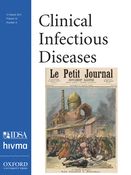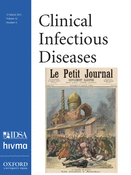
Cover image

On the cover: “Cholera in Russia: The Troubles in Astrakhan”, color lithograph, from Le Petit Journal, 6th August 1892, by Henri Meyer (French) (1844-99). Giraudon collection. The Bridgeman Art Library International, Reproduced with permission.
The depicted riots at Astrakhan, Russia (1892), are historic examples of public disorder that can result from ignorance and misinformation, regardless of the best efforts of medical personnel in the course of a major epidemic. The artist Henri Meyer never actually visited this scene nor that of many other sensational disasters which he illustrated for the cover of the Parisian newspaper, Le Petit Journal. Meyer's sensational narrative images were meant to draw attention and to sell newspapers. He also illustrated books by Jules Verne.
The Russian cholera epidemic of 1892–93 struck first in the city of Astrakhan, at the mouth of the Volga River, with a rapid spread and an unusually high mortality rate. Between June 14 and July 31, 1892, seventy percent of the 4,499 cholera victims succumbed the disease.
As it struck the lower classes especially hard, mass hysteria and riots erupted. The public referred to cholera as “ona” (“she”), as if the mere uttering of the word were ominous. According to the writer N. G. Korolenko (1853-1921), uneducated, frightened people had contrived a sinister theory that the government had deliberately caused the epidemic in order to kill off the poor.
“'When the steamship approached the quarantined ships [in Astrakhan Harbor], it seems that it bore neither a fresh supply of water nor bread for those detained. Instead of all this, the steamship brought – coffins. The implication that it gave to the crowd was unusually clear: it had been decreed to kill as many people as there were coffins“. 1
On the mainland, fear turned to anger as a frenzied mob invaded the cholera hospital, attacked physicians, “rescued” patients, and burned down the buildings. Finally, a military attachment was sent to disperse the crowd and arrest the leaders of the riots. (Mary& Michael Grizzard, Cover Art Editors)
1 See Korolenko citation, and more about cholera in Astrakhan in NancyM. Frieden, “The Russian Cholera Epidemic, 1892–93, and Medical Professionalism”, Journal of Social History, vol. 10, No. 4, summer 1977. pp. 538–559.
Volume 52, Issue 6, 15 March 2011
15 March News
News
In the Literature
In the Literature
MAJOR ARTICLES AND COMMENTARIES
Clinical Experience in Adults and Children Treated with Intravenous Peramivir for 2009 Influenza A (H1N1) Under an Emergency IND Program in the United States
Peramivir, an investigational intravenous neuraminidase inhibitor, was given to 31 hospitalized patients with severe viral pneumonia during the 2009 H1N1 influenza pandemic under the Emergency IND regulations. The drug was generally well tolerated and associated with recovery in most patientes.
Peramivir: Another Tool for Influenza Treatment?
Enteroviral Infection of a Cardiac Prosthetic Device
Case report of a trisomic infant with cardiac prosthetic device who presented three recurrences of culture negative endocarditis. Coxsackie virus was the only pathogen recovered from the endocardial tissue and its role as etiological agent of the infection is discussed.
Glyburide Is Anti-inflammatory and Associated with Reduced Mortality in Melioidosis
Patients with diabetes have better survival from septic melioidosis than patients who without diabetes. This difference was seen only in patients taking glyburide prior to presentation and was associated with an anti-inflammatory effect of glyburide.
Decreased Infection-Related Mortality and Improved Survival in Severe Aplastic Anemia in the Past Two Decades
Survival in aplastic anemia has markedly improved in recent decades. In multivariate analysis, the introduction of newer antifungal agents and a decrease in fungal infections were independent predictors for survival in the months following immunosuppression among patients with persistent neutropenia.
A Randomized Study Comparing Combined Pneumococcal Conjugate and Polysaccharide Vaccination Schedules in Adults
Combined schedules of pneumococcal conjugate and polysaccharide vaccines do not provide enhanced immunogenicity for the seven serotypes tested in comparison to a single dose of pneumococcal conjugate vaccine in adults.
Foodborne Nosocomial Outbreak of SHV1 and CTX-M-15–producing Klebsiella pneumoniae: Epidemiology and Control
Klebsiella pneumoniae has been frequently associated with nosocomial outbreaks. A unique foodborne nosocomial outbreak due to a SHV-1 and CTX-M-15-producing K. pneumoniae is described.
REVIEW ARTICLE
β-D-Glucan Assay for the Diagnosis of Invasive Fungal Infections: A Meta-analysis
This meta-analysis shows that serum or plasma (1←3)-β-D-glucan has pooled sensitivity of 77% and specificity of 85% for the diagnosis of proven or probable invasive fungal infections. However, there was considerable heterogeneity in the characteristics of the 16 analyzed studies.
BRIEF REPORTS
Osteoperiostitis in Early Yaws: Case Series and Literature Review
Staphylococcus aureus Oropharyngeal Carriage in a Prison Population
PHOTO QUIZ
An HIV-Positive Male with a Herald Plaque
INVITED ARTICLES
HIV/AIDS
Update on Human Immunodeficiency Virus (HIV)-2 Infection
FOOD SAFETY
Vibrio vulnificus Oysters: Pearls and Perils
HIV/AIDS
The Spectrum of Engagement in HIV Care and its Relevance to Test-and-Treat Strategies for Prevention of HIV Infection
Poor engagement in HIV care is common in the United States and worsens HIV treatment outcomes. In addition, poor engagement in care is likely to drastically reduce the effectiveness of “test and treat” HIV prevention strategies.
“Test and Treat”: Is It Enough?
Patterns and Characteristics of Hepatitis C Transmission Clusters among HIV-Positive and HIV-Negative Individuals in the Australian Trial in Acute Hepatitis C
HCV transmission networks within the Australian Trial in Acute Hepatitis C occurred predominantly in HIV positive populations and almost exclusively in men who have sex with men. Both sexual and injecting drug use risk were observed within the same clusters.
Incident Hepatitis C Virus Infection among US HIV-Infected Men Enrolled in Clinical Trials
HCV incidence from 1996-2008 among HIV-infected men in U.S. HIV therapeutic trials was 0.51 per 100 person-years. Incident HCV occurred primarily through non-parenteral means; 75% of seroconverters reported no drug injection. At-risk HIV-infected persons should have access to HCV surveillance
Cumulative Exposure to Cell-Free HIV in Breast Milk, Rather Than Feeding Pattern per se, Identifies Postnatally Infected Infants
In a nested case-control study, postnatal HIV infection was strongly associated with cumulative HIV RNA breastmilk exposure, even after allowing for maternal CD4 and plasma viral load; cases ingested approximately 15 times more HIV-1 RNA particles than controls.
ANSWER TO THE PHOTO QUIZ
An HIV-Positive Male with a Herald Plaque
CORRESPONDENCE
Seasonal Influenza Vaccination and the 2009 Pandemic
The 2009 Provincial Decision to De-emphasize Seasonal Influenza Vaccine in Canada: Real-Time Risk-Benefit Analysis
Reply to Mercer and Kelly and to Kendall
Mechanism for Seasonal Vaccine Effect on Pandemic H1N1 Risk Remains Uncertain
Reply to Skowronski
Antimicrobial-Resistant Nocardia Isolates, Taiwan, 1998–2009
ELECTRONIC ARTICLE
Geosmithia argillacea: An Emerging Cause of Invasive Mycosis in Human Chronic Granulomatous Disease
We report the first cases of invasive mycosis by G. argillacea in chronic granulomatous disease, CGD (an inherited disorder of the NADPH oxidase), patients. G. argillacea is a previously underappreciated and frequently misidentified pathogen in CGD that should be excluded when P. variotii is identified morphologically.



